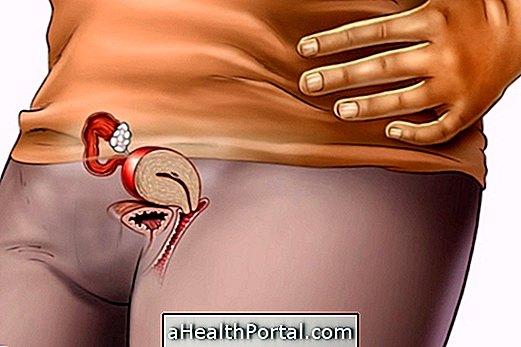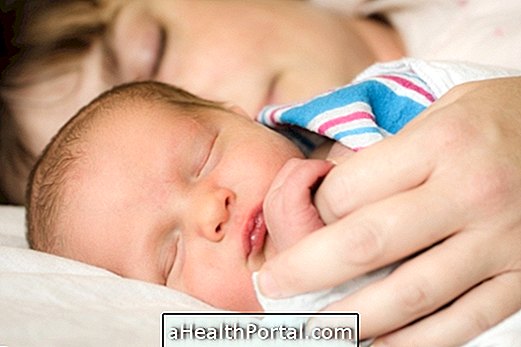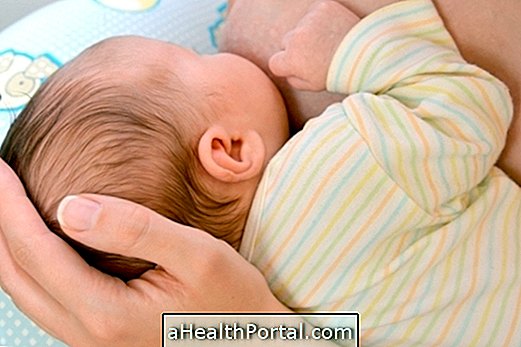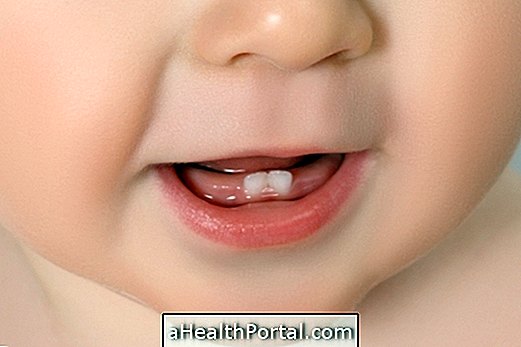To count the days and months of pregnancy, one must take into account that the first day of gestation is the first day of the woman's last menstrual period, and although the woman is not yet pregnant on that day, this is the date that health care because it is very difficult to know exactly when the woman ovulated and when the conception happened.
Complete gestation lasts on average 9 months, and although it may reach 42 weeks of gestation, doctors can induce labor if labor does not start spontaneously until 41 weeks and 3 days.
1 month - Up to 4 and a half weeks' gestation
At this stage the woman probably still does not know that she is pregnant, but the fertilized egg has already implanted in the uterus and what maintains the pregnancy is the presence of the corpus luteum. See what are the first 10 symptoms of pregnancy and the expected date of delivery.

2 months - Between 4 weeks and a half to 9 weeks
At 2 months of pregnancy the baby already weighs 2 to 8 g. The baby's heart begins to beat at about 6 weeks of gestation and although it is still similar to a bean, it is at this stage that most women find out they are pregnant. Malaise and morning sickness are typical of this phase and usually last until the end of the third month of gestation. They are caused by hormonal changes and some useful tips are: avoid intense aromas and rest, as tiredness tends to increase nausea. Here's how to relieve this symptom: Home remedy for nausea in pregnancy.
3 months - Between 10 and 13 weeks and a half
At 3 months pregnant the embryo measures almost 10 cm, weighs between 40 and 45 g, and begin to form ears, nose, bones and joints, and the kidneys begin to produce urine. At the end of this phase, the risk of spontaneous abortion decreases as well as nausea. The belly begins to appear and the breasts become increasingly bulky, which increases the risk of getting stretch marks. Learn How to Avoid Stretch Marks in Pregnancy and What Exams Do in Pregnancy.

4 months - Between 13 weeks and a half and 18 weeks
At 4 months of pregnancy the baby measures about 15 cm and weighs about 240 g. It begins to swallow the amniotic fluid, which helps to develop the alveoli of the lungs, already sucks the finger and the fingerprints are already formed. His thin skin is covered by the lanugo, and although the eyelids of the eyes are closed, he already notices the difference between the lightness and the darkness. Morphological ultrasonography will be able to show the baby to parents, but the baby's sex should not yet be revealed. See a popular method for knowing the sex of the baby in: Table to know the sex of the baby.
5 months - Between 19 and 22 weeks of gestation
At 5 months of pregnancy the baby measures about 30 cm and weighs about 600 g. The arms and legs become more proportionate to the body and it becomes more and more like a newborn baby. He begins to hear the sounds and particularly the voice and heartbeat of the mother. Nails, teeth and eyebrows begin to form. The pregnant woman may have a darker line from the navel to the genital area and training contractions may appear.
6 months - Between 23 and 27 weeks
At 6 months of pregnancy the baby measures between 30 and 35 cm and weighs between 1000 and 1200 g. He begins to open his eyes, has a sleep routine and has a better developed palate. Your hearing is getting more and more intense and the baby can already perceive the external stimuli, responding to the touch or frightening themselves with loud noises. The baby can notice the movements of the baby more easily and so, caressing the belly and talking to him can calm him. Here's what you can do to get your baby moving: 5 ways to stimulate the baby still in the belly.

7 months - Between 28 and 31 weeks
At 7 months the baby measures about 40 cm and weighs about 1700 g. Your head is bigger and the brain is developing and expanding, so the baby's nutritional needs are getting bigger. The baby moves with more liveliness and his heartbeats can already be heard with a stethoscope. Parents should start buying the necessary items for the baby, such as the clothes and the crib, and prepare the bag to take to the maternity. Find out what to bring to the hospital at: Mom's lay in the hospital and baby's lay in the hospital.
8 months - Between 32 and 36 weeks
At 8 months of pregnancy the baby measures about 45 to 47 cm and weighs about 2500 g. It begins to move the head from side to side, the lungs and the digestive system are already properly formed, bones become stronger and stronger, but it will have less space to move around and, therefore, it is normal for pregnant women less notice the baby's movements. For the pregnant woman, this phase can be uncomfortable because the legs become more swollen and the varicose veins may appear or worsen, so walking for 20 minutes in the morning may help. Here's how to feel better at the end of pregnancy: How to relieve discomfort in late pregnancy.
9 months - Between 37 and 42 weeks
At 9 months of pregnancy the baby measures about 50 cm and weighs between 3, 000 and 3, 500 g. Regarding development, the baby is fully formed and is only gaining weight. In these weeks the baby should be born, but he has until 41 weeks and 3 days to come to the world. If the contractions do not start spontaneously until this time, the doctor will probably have to induce labor with synthetic oxytocin in the hospital. Learn how to recognize the early signs of labor.
Your pregnancy by quarter
To make your life easier and you do not waste time looking, we separate all the information you need for each trimester of gestation. What quarter are you in?
- 1st Quarter (1st to 13th week)
- 2nd Quarter (14th to 27th week)
- 3rd Quarter (from the 28th to the 41st week)






















